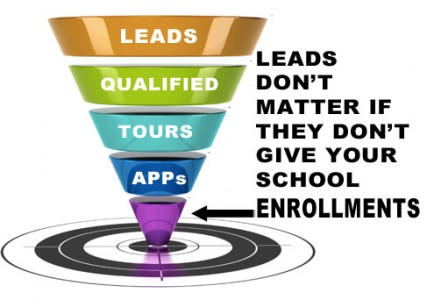 As an industry, private and vocational schools spend millions of dollars advertising every month – The Apollo Group does that on their own (and that’s just search engine marketing). Most of us, however, don’t have that sort of budget, so need more viable advertising ideas for our school. In this article we’ll cover the two major school marketing and advertising areas: those that require time (grass roots marketing), and those that require money (advertising).
As an industry, private and vocational schools spend millions of dollars advertising every month – The Apollo Group does that on their own (and that’s just search engine marketing). Most of us, however, don’t have that sort of budget, so need more viable advertising ideas for our school. In this article we’ll cover the two major school marketing and advertising areas: those that require time (grass roots marketing), and those that require money (advertising).
Before we go into the different ways to advertise a school, it’s important to note the absolute importance of marketing within a school’s business operations. When a school is up and running with a steady inflow of new enrollments, you want to be re-investing at least 10-12% of your revenue on marketing. Similarly, a new school needs to have at least 6 month’s worth of high-saturation marketing capital on hand for a proper launch. If you open a new school slowly… you’ll end up opening really slowly. Soft launches for schools more often result in failure than they do success (mainly because your fixed costs are the same for 5 students as they are for 100, so you run out of money before you ever get started). If you haven’t started your school yet: wait until you have enough money to properly launch with a decent ad blitz.
Admittedly, there are times when a school might be forced to decrease its school marketing budget. If that happens, you must simultaneously increase the amount of time you spend on your marketing efforts (that’s the school marketing budget equation detailed more below). No matter how tight your budget, you absolutely cannot decrease your “total” marketing: the combination of paid advertising, promotional events, grass roots outreach, etc. If you cut back, your school inevitably will get stuck in the downward spiral of decreasing enrollments.
Before anything, know your market: the student
How do you compete when stuck with a smaller advertising budget? The key, honestly, is staying focussed on your students: who they are and what they want, then you can effectively market your school’s programs without spending *too* much money on trying out new school advertising ideas. There’s no single magic advertising channel for schools, so you have to know your target market – your students – almost better than they know themselves. Once you do that, then you’ll know the two most important aspects of a successful marketing campaign:
- where they spend their time, and;
- who do they trust.
Knowing those two things tell you where to advertise your school and who the influencers are for your target demo. While it’s highly unlikely you’re going to get the influencers to endorse or even be a spokesperson, you can at minimum use that knowledge to know how the message should be delivered, packaged, worded, etc.
Time and time again I work with schools and businesses who always say: “we know who our target market is.” The truth is: we never know with 100% certainty where all our target markets are. As a school you need to constantly be asking students, graduates, and potential employers about their habits and background. You’ll be surprised how many new niches pop up every time you make the effort to do some survey-based market research.
The marketing budget: money (x) effort
If budget is your primary factor, then the bottom line is you’ll have to work a lot harder: put in more hours on organically and locally promoting your school. If you can’t pay for it, then you have to do the footwork on your own.
I always say that schools and businesses need to view their marketing plans as a combination of money and effort. Money is spent on getting quick awareness, and doesn’t require a lot of hours to complete like advertising and sponsorships. Effort requires people and time: interaction on social networks, attending industry gatherings… event hitting the pavement to pass out flyers at coffee shops on the weekend.
If your school’s marketing budget is being decreased given the current economic situation (or for any reason), then you MUST counterweight that decrease in spending with an increase in effort so that the “total marketing” remains at a level you need to keep enrolling new students.
School marketing ideas that cost little money, but require time to do correctly
Social Media Marketing. This is interaction on social media, not advertising there (social media advertising is covered further down). It’s a humbling experience because you are basically asking and hoping for people to like and follow your school. Spend an hour each day to post something relevant to your industry as well as search for other pages and people who might be interested in you: like or follow them, say hello and let them know about your school. Make sure all of your graduates and current students are fans. If your school can offer a service, think about online competitions that you can host on your fan page with voting or polls. Get your faculty involved with posting interesting content. If you can have at least 3 good posts every day while still having time to find, like, and get to know new businesses and people then you’re in good shape.
Have a high quality blog on your website. But don’t think of it as “blogging” which often serves as a mental impasse. Approach it like information marketing: article publishing. The Internet is all about accessing information. Anyone interested in your school will most likely first be looking for basic information about possible careers, salary ranges, and lots of do it yourself tutorials (if applicable). Using your website blog as information marketing will help prospective students find you as well as enhance your authority in the industry by demonstrating your expertise. It’s why large universities have their professors publish books: establish topic authority and prestige for the institution.
 SEO for your vocational or career school website. Comments, guest posts and links. This part is boring, drab, humbling, annoying, etc. etc. etc. Yes, you could pay a company to get you a ton of low quality links in a short period of time, but Google and the other search engines are smart: they can identify that as bad link building, and it can potentially result in your site being punished in its search ranking. Do it right by doing it for real: publish great content people will want to link to. Find other websites that have content related to your industry and comment with a link to your site. Marketing your school on article websites can be a little tedious, but all it requires is your time, and it’s a huge help with search engine rankings.The key is to get high quality links back to your own website. It takes time and it’s not much fun, but you need to spend the time to do it.
SEO for your vocational or career school website. Comments, guest posts and links. This part is boring, drab, humbling, annoying, etc. etc. etc. Yes, you could pay a company to get you a ton of low quality links in a short period of time, but Google and the other search engines are smart: they can identify that as bad link building, and it can potentially result in your site being punished in its search ranking. Do it right by doing it for real: publish great content people will want to link to. Find other websites that have content related to your industry and comment with a link to your site. Marketing your school on article websites can be a little tedious, but all it requires is your time, and it’s a huge help with search engine rankings.The key is to get high quality links back to your own website. It takes time and it’s not much fun, but you need to spend the time to do it.
Become an expert. Find industry magazines or websites and contact the publisher. Suggest and pitch your own articles for their publication. Build your school’s authority by getting published and “giving away” some information in the form of articles, tutorial videos, and even short papers people can download as PDFs.
Get personal. When schools are full of students, you don’t always have time to personally get to know leaders in your local industry. When your marketing budget is restricted, your MUST network personally with people working in the industry for which you school prepares students. Print an extra 1000 business cards, start Googling for addresses, and get to know them. These people are often asked about how they started in their own careers, so if they like your school (and you), then they’ll recommend attending your program(s).
Career advisers and high school counselors. Like people working in the industry, if education advisers and high school guidance counselors know and like you personally, they are more likely to remember and therefore recommend your school to students who they think would be a good fit.
Use your internship and externship partners. For example, if your school teaches a CMA program and works with clinics to complete externship hours: place your brochures in their waiting rooms.
School marketing ideas that cost money, but not much time
Search Engine Marketing. This is the core of any school advertising plan. Of all the advertising channels it continues to have the highest conversion rates, and it’s easy to see why: a person who goes to Google and types, “CMA schools in Dallas”, is a very hot lead. They already know what they want and where to buy it. All you have to do is close the deal. It’s important to note, however, that schools MUST have good tracking. Use Google’s conversion tools and a Admissions CRM so you know which campaigns work and which do not. It’s easier to waste money with SEM as it is to make it. (There’s a litlte more about advertising a school online on poliARC.)
 Social media advertising. Social media ads are a sort of double-edged sword. On one hand, the vast majority – if not literally 100% – of your prospective students have a facebook and handful of other social media accounts. Since you can target social media ads by interest, connections, and geography, you have decent ability to make sure you’re displaying your ads to the correct group of people. The downside is that when a person is on social media, they are not shopping: they’re social surfing. It’s a completely different mindset, and so the conversion rates from click to captured inquiry (let alone enrollment) on social media are very low. As a result, the cost per click is also a lot less expensive than search engine marketing. Given that truth, so long as you use social media advertising as a piece of a larger campaign, then you might see some benefit from it: integrate it into your grass roots social media marketing plan and make sure you’re using your CRM and admissions reps to keep them engaged.
Social media advertising. Social media ads are a sort of double-edged sword. On one hand, the vast majority – if not literally 100% – of your prospective students have a facebook and handful of other social media accounts. Since you can target social media ads by interest, connections, and geography, you have decent ability to make sure you’re displaying your ads to the correct group of people. The downside is that when a person is on social media, they are not shopping: they’re social surfing. It’s a completely different mindset, and so the conversion rates from click to captured inquiry (let alone enrollment) on social media are very low. As a result, the cost per click is also a lot less expensive than search engine marketing. Given that truth, so long as you use social media advertising as a piece of a larger campaign, then you might see some benefit from it: integrate it into your grass roots social media marketing plan and make sure you’re using your CRM and admissions reps to keep them engaged.
Use scholarships. Most state regulatory agencies allow post-secondary schools to offer scholarships so long as they are fairly offered to “everyone”. You can use that to help buttress course start dates that traditionally have smaller enrollment numbers, and it’s a way to offset your “spending”. If “All students who enroll in our January start date receive $1000 off tuition!” then you’re likely to get a couple extra students, which will at worst balance out the lost of income per student. The net benefit is you have a full class, which always helps student retention and word of mouth marketing, so by the end of the day you’re revenue is likely to be more than had you not offered the scholarships.
Email. Email marketing can actually be fairly inexpensive, but it’s also something that has to be constantly refined, more so that other channels. For private and post-secondary schools, email is best used as a reminder more than a method to find new leads. Yes, you can lease email lists from industry-specific publications and pick up a few leads here and there, but overall the cost per student tends to not be viable. If you want to use third-party lists, try to get a couple sends as add-ons to another ad package like print and banner advertising on their website. When curating your own email marketing list the problem is that everything you send must be interesting and somehow valuable to the person receiving it. If all you send are announcements of your next open day, they’ll quickly default your emails to being spam and never read them again. As such, you want your email marketing to be very targeted. first on program and inquiry date range, then whittle down as appropriate from there so that the content of each email is as targeted as possible.
And finally…
Accept that enrolling students is sales. This is often hard to accept, but in private education, marketing your school is just as much sales as it is anything else. If you’re inquiry to enrollment ratio is low, spend money on hiring a really good, and fairly aggressive recruiter. Successful schools have recruiters on the phone all day long, calling back leads to get them to make an appointment to tour the school and meet with an admissions representative. You can spend all the money you want on advertising, but a large chunk of it will be wasted if you don’t have a staff that’s good at closing the deal.








